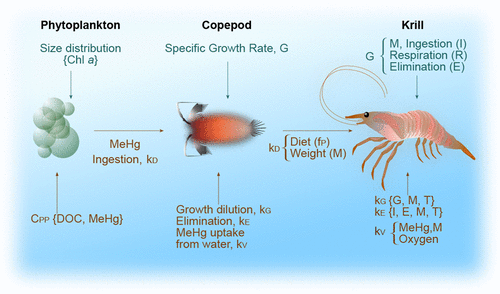当前位置:
X-MOL 学术
›
Environ. Sci. Technol.
›
论文详情
Our official English website, www.x-mol.net, welcomes your
feedback! (Note: you will need to create a separate account there.)
A Model for Methylmercury Uptake and Trophic Transfer by Marine Plankton
Environmental Science & Technology ( IF 10.8 ) Pub Date : 2017-12-29 00:00:00 , DOI: 10.1021/acs.est.7b03821 Amina T. Schartup 1, 2 , Asif Qureshi 2, 3 , Clifton Dassuncao 1, 2 , Colin P. Thackray 1 , Gareth Harding 4 , Elsie M. Sunderland 1, 2
Environmental Science & Technology ( IF 10.8 ) Pub Date : 2017-12-29 00:00:00 , DOI: 10.1021/acs.est.7b03821 Amina T. Schartup 1, 2 , Asif Qureshi 2, 3 , Clifton Dassuncao 1, 2 , Colin P. Thackray 1 , Gareth Harding 4 , Elsie M. Sunderland 1, 2
Affiliation

|
Methylmercury (MeHg) concentrations can increase by 100 000 times between seawater and marine phytoplankton, but levels vary across sites. To better understand how ecosystem properties affect variability in planktonic MeHg concentrations, we develop a model for MeHg uptake and trophic transfer at the base of marine food webs. The model successfully reproduces measured concentrations in phytoplankton and zooplankton across diverse sites from the Northwest Atlantic Ocean. Highest MeHg concentrations in phytoplankton are simulated under low dissolved organic carbon (DOC) concentrations and ultraoligotrophic conditions typical of open ocean regions. This occurs because large organic complexes bound to MeHg inhibit cellular uptake and cell surface area to volume ratios are greatest under low productivity conditions. Modeled bioaccumulation factors for phytoplankton (102.4–105.9) are more variable than those for zooplankton (104.6–106.2) across ranges in DOC (40–500 μM) and productivities (ultraoligotrophic to hypereutrophic) typically found in marine ecosystems. Zooplankton growth dilutes their MeHg body burden, but they also consume greater quantities of MeHg enriched prey at larger sizes. These competing processes lead to lower variability in MeHg concentrations in zooplankton compared to phytoplankton. Even under hypereutrophic conditions, modeled growth dilution in marine zooplankton is insufficient to lower their MeHg concentrations, contrasting findings from freshwater ecosystems.
中文翻译:

海洋浮游生物对甲基汞的吸收和营养转移的模型
海水和海洋浮游植物之间的甲基汞(MeHg)浓度可以增加100000倍,但不同地点的水平有所不同。为了更好地了解生态系统特性如何影响浮游式甲基汞浓度的变化,我们建立了以海洋食物网为基础的甲基汞吸收和营养传递模型。该模型成功地再现了西北大西洋不同地点浮游植物和浮游动物中测得的浓度。在低溶解有机碳(DOC)浓度和开阔海洋地区典型的超寡营养条件下,模拟了浮游植物中的最高MeHg浓度。发生这种情况的原因是,与MeHg结合的大型有机配合物会抑制细胞摄取,并且在低生产率条件下细胞表面积与体积之比最大。2.4 –10 5.9)比浮游动物(10 4.6 –10 6.2)在海洋生态系统中通常存在的DOC(40–500μM)和生产力(超营养养分到富营养化)的范围内变化更大。浮游动物的生长稀释了他们的甲基汞的身体负担,但它们也以较大的体积消耗大量的富含甲基汞的猎物。与浮游植物相比,这些竞争过程导致浮游动物中MeHg浓度的变异性较低。即使在富营养化条件下,海洋浮游动物中模拟的生长稀释度也不足以降低其MeHg浓度,这与淡水生态系统的发现形成了鲜明对比。
更新日期:2017-12-31
中文翻译:

海洋浮游生物对甲基汞的吸收和营养转移的模型
海水和海洋浮游植物之间的甲基汞(MeHg)浓度可以增加100000倍,但不同地点的水平有所不同。为了更好地了解生态系统特性如何影响浮游式甲基汞浓度的变化,我们建立了以海洋食物网为基础的甲基汞吸收和营养传递模型。该模型成功地再现了西北大西洋不同地点浮游植物和浮游动物中测得的浓度。在低溶解有机碳(DOC)浓度和开阔海洋地区典型的超寡营养条件下,模拟了浮游植物中的最高MeHg浓度。发生这种情况的原因是,与MeHg结合的大型有机配合物会抑制细胞摄取,并且在低生产率条件下细胞表面积与体积之比最大。2.4 –10 5.9)比浮游动物(10 4.6 –10 6.2)在海洋生态系统中通常存在的DOC(40–500μM)和生产力(超营养养分到富营养化)的范围内变化更大。浮游动物的生长稀释了他们的甲基汞的身体负担,但它们也以较大的体积消耗大量的富含甲基汞的猎物。与浮游植物相比,这些竞争过程导致浮游动物中MeHg浓度的变异性较低。即使在富营养化条件下,海洋浮游动物中模拟的生长稀释度也不足以降低其MeHg浓度,这与淡水生态系统的发现形成了鲜明对比。









































 京公网安备 11010802027423号
京公网安备 11010802027423号